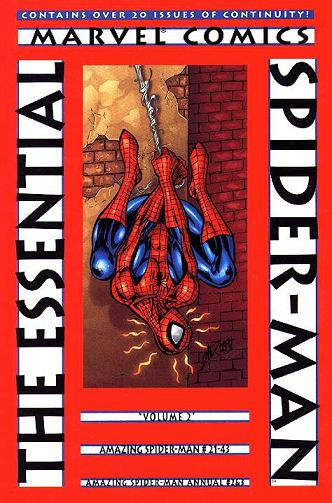
Essential Spider-Man Vol. 2
Stan Lee, Steve Ditko, John Romita and friends
Reprints: Amazing Spider-Man #21-43, Annual 2-3 (Februari 1965 – December 1966)
Get this for: Lee, Ditko & Romita on Spider-Man– five stars
After finishing Essential Spider-Man Vol. 1 I needed to finish the rest of the Lee-Ditko run on Amazing Spider-Man, so onwards to Vol. 2 I went. This includes the last eighteen issues plus annual Ditko worked on the title, as well as the first few of John Romita as his replacement. The changeover from the stylistic mastery of Ditko to the much more conventional prettiness of Romita is jarring and when read straight after each other, Romita comes off looking the lesser artist, almost bland even. Not that he’s a bad artist of course, but he lacks the personal investment Ditko brought to Spider-Man.
The story of why Ditko left Amazing Spider-Man is well known of course: he objected to taking the Green Goblin and make him into somebody in Spidey’s supporting cast like Stan Lee wanted him to be as that would make for a better story, rather than having him just be a nobody as Ditko wanted as that fit his philosophy of crime (heavily influenced by Ayn Rand) better. Ditko quit with the issue in which Lee wanted the big reveal rather than compromise his principles, Romita was brought in and Spider-Man would never be the same again. So much of what would make Spider-Man Spider-Man later on was only brought in after Ditko left, the most important perhaps being a certain little gal called Mary Jane Watson! (One risk of reading these volumes back to back is having Lee’s speech patterns rub off on you. But that’s a risk I’m taking for you, the dedicated reader. (See what I mean?))
With Romita Spider-Man went even more into soap opera, lost some of the easy humour of the Ditko days as Peter Parker’s struggles were taken more seriously and the cast was expanded. For most of Ditko’s run there’s only a relatively small supporting cast: Flash Thompson and Liz Allen plus unnamed hangers on at Peter’s high school; Jolly Jonah Jameson, Betty Brant and Frederick Foswell at the Daily Bugle, plus of course Aunt May. Even Harry Osborn and Gwen Stacy only come into the picture at the end of the Ditko issues. With Romita on board, the cast becomes bigger and more important. It’s quite a difference.
Moving back to why Ditko left the series, it has been interesting to see, knowing his reasons, how he had been weaving his thoughts on crime and the losers who commit in the series before. In the previous volume there was the crime boss The Big Man, who Spider-Man suspected was actually Jameson himself only for him to turn out to be Foswell, while this volume has the saga of the Crime-Master, where Spidey is again wrong in his suspicions, now thinking Foswell has gone back to his old ways when it turns out it’s somebody he actually never saw and nor did we. In both cases it turns out our ideas of who could be this big, important villain don’t matter as they turn out to be nobodies, which is what Ditko wants us to learn about crime. With the Goblin he had been careful never to show his face before and was on his way to repeat this trick, but Lee had other plans. A pity in one way, though Lee had a good case that storywise, it’s more satisfying to have the revelation of the Goblin’s identity be more meaningful. In the end, because Norman Osborn is only introduced a few issues before anyway, any shock value of his being the Green Goblin is slight.
One of the strangest stories in this volume is issue 24, where Spidey thinks he’s going mad because he keeps seeing hallucinations while some psychatrist has written an op-ed in the Bugle that he must be insane to be Spider-Man. It’s not the story itself which is strange, as the logic behind the premise. Even before Spidey sees things, the mere mention that a psychiatrist has declared him insane was enough for him to doubt his sanity. That’s the kind of childlike logic more suited to a Superboy story, where any autority is always immediately believed by the hero and his friends, no matter how ludicrous.
Ditko or Romita, Spider-Man is addictive. I have to imagine what it would’ve been like to read these issues straight from the newsstand back in ’65, having to wait a month to read the conclusion of the Master Planner story, Ditko’s zenith on the series. So good to be able to just flip the page and start reading.